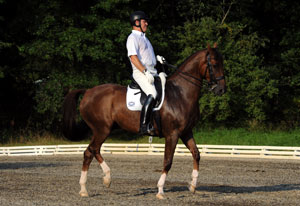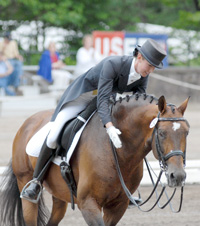Read award-winning journalist Nancy Jaffer’s latest report on the world of equestrian sport. Brought to you by Practical Horseman magazine. Visit Nancy’s archive for past columns.

July 16, 2010 — The devastating head injury suffered by dressage Olympian Courtney King-Dye in a terrible fall last March has generated a dramatic reaction that could well end in a mandatory protective riding helmet requirement for her discipline at least in the United States–and perhaps elsewhere as well.
Courtney was far from the first person riding without a helmet to suffer a horrific head injury, but what happened to her captured people’s attention, immediately and convincingly. Was it the fact that her rise to the top had been well-documented and followed eagerly over recent years by the public? Or that someone so young, attractive and athletic could be laid low in an instant. And, as a corollary, if it happened to her, it could happen to anyone?
An object lesson from Courtney’s fall is how it affected her family and friends, whose support has been vital to her recovery (read this exclusive interview with Courtney). Waiting through the weeks she was in a coma, when they didn’t know her fate, took a toll that was greater on them than it was on her worried fans. The increased recognition that a head injury affects far more than one person has convinced some to put on a helmet simply because they’re concerned about those around them, even if they’re cavalier about themselves.
The first National Helmet Awareness Day July 10 was a huge success. Presented by the new riders4helmets organization backed by one of Courtney’s sponsors, SUCCEED, it drew attention to the need to wear a helmet with a gathering at the Kentucky Horse Park that included a variety of testimonials and demonstrations.
They included how a cantaloupe fared when dropped from a height of 13 feet (equivalent to a rider mounted on a horse) while wearing a helmet (not a dent) and not wearing a helmet (ouch!). One non-helmet-wearing cantaloupe smashed completely and a second broke open. More than 200 retailers offered discounts on protective headgear around the country that day, and Lyndsey White, co-founder of riders4helmets, said queries came from several foreign countries about starting a similar initiative.
Rule Change Discussions
Meanwhile, there’s been a lot of buzz about the possibility of a mandatory helmet rule for dressage. The FEI (international equestrian federation) came out with a statement from its dressage committee that “strongly” recommends riders wear protective headgear while training and warming up for competition. They continue to have the option of wearing protective headgear in the arena, but some top-level riders fear that doing so will single them out in the eyes of the judges, perhaps indicating that their horses are difficult.
There is a way to solve that, however.
“If everybody wore a helmet, everybody would look the same,” said Michael Barisone, a Grand Prix rider and member of the U.S. Equestrian Federation’s (USEF) High Performance Dressage Committee.

John Long, the USEF’s CEO, noted the concept of requiring dressage riders in this country to wear protective headgear is “really only in the discussion stage at this point. I think it will be a longer process.” Unlike the FEI recommendation, however, John believes, “If we’re going to do it, it should be in the warm-up areas and during competitions.”
But the USEF is far from that point now, and not every Grand Prix rider agrees with Michael’s perspective. Many feel the choice should be left up to the individual. “There’s lot of tradition that is balanced against safety. I suspect this is not going to happen any time soon,” John concluded, “but it’s good that we’re talking about it, because once the collective equestrian family gets it out on the table, something good will come out of it.”
Michael, however, would like to go much further, and in the current climate favorable to helmets that was created by Courtney’s accident and insurance considerations, it may be possible to advance such ideas.
“My personal opinion is it should be mandated for all equestrian sport, anytime when mounted, all over the world. You can’t bicycle race without a helmet, you can’t play hockey without a helmet, you can’t play football without a helmet,” he pointed out.
“I probably have not been diligent over my career, thinking I’m invincible,” he conceded. But Courtney’s accident and the broken pelvis suffered by three-time Olympian Guenter Seidel (who was wearing a helmet when he fell last month) demonstrate that “any and all of us can get hurt. It’s cheap and easy insurance to see that head injury is plucked out of the equation, or at least to minimize it,” he said.
A Grassroots Effort
The grassroots response to Courtney’s accident has gathered momentum fast. After Courtney’s fall, when no one was sure what her future would hold, California photographer Sheryl Ross went into action.
“When I heard about her accident, I was deeply moved by it. The first thing I thought was, ‘What can I do to help?'” She contacted a designer friend in New York and California photographer Terri Miller, who gave her an image she could use for a “Come Back Court” T-shirt and posters.
The site “did fabulous; we got several thousand dollars for her,” Sheryl said.

Once Courtney came out of her coma, Come Back Court had completed its mission. But another separate initiative was beginning. Jeri Bryant, a California amateur dressage rider with marketing expertise, said Courtney’s accident “flipped a switch in my brain.”
“I’ve not always consistently worn a helmet,” Jeri admitted, citing the fact that they can be “inconvenient and cumbersome.” But you won’t catch her without one now.
“It’s never too late to change your view on that,” she pointed out.
She came up with the slogan, “Strap One On” and created a T-shirt with the slogan. After printing 36 of them herself, she wore one to a local feed store, and it started a discussion.
“This is a good idea,” she decided.
She contacted Lyndsey White, who was running an eBay store to benefit Courtney, and asked to donate the shirts. That was the root of riders4jelmets, as the idea caught on and the website riders4helmets.com was developed. It has taken on a life of its own and continues to fulfill Jeri’s objective.
“I wanted to raise awareness. What got me with Courtney was that this was just a slip” by the horse she was riding, Jeri said. “Why should anybody put themselves at risk? If it changes one person’s perspective, then I’m happy with that.”
Justice for Sapphire and McLain
As a follow-up to the FEI mea culpa on the incorrect elimination of McLain Ward’s mount, Sapphire, from the second round of the Rolex FEI Show Jumping World Cup finals, the international federation issued new mandatory guidelines on how the hypersensitivity issue will be handled from now on in an attempt to avoid similar injustices. Included is a provision enabling a rider to ask that his or her mount can be re-presented to officials if the horse has been eliminated for hypersensitivity more than 12 hours before the next segment of a competition–a privilege denied to McLain.
“I think the FEI has made some very bold statements and with implementation of these guidelines, I think it’s a win/win for everybody out of a very bad situation,” USEF’s John Long observed.
While commenting, “I think we all learned a big lesson from what happened in Geneva,” he hopes that down the road implementation of this protocol can involve more objective standards.
“The technology that is part of thermographic exams is not as sophisticated as it will probably be in another year or so. We’re still relying a lot on the experienced hands of veterinarians when they do the physical exams,” he said.
“It would be really important to get to the point where we would be able to say the horse is either sensitive or not, based on an objective determination of thermography and other devices,” he commented.
While restoring McLain’s points and prize money from the second round in a decision earlier this month, the FEI held that Sapphire’s elimination from the final round, in which she was not permitted to compete, remained in place. Some wondered why the USEF had not pursued redress for that, since McLain was leading the standings when he was eliminated.
“We looked at all of the possible alternatives, including going to the CAS (Court of Arbitration for Sport),” John said, but the USEF decided the case should be wrapped up with the awarding of money and points, as well as the issuance of the new guidelines.
“How do you go back in time and hypothesize what would have happened if he had been allowed to go in the final (segment)?” he asked.
“The CAS, I don’t believe, would even have taken that on,” he said, contending the USEF got what it wanted: “To make sure the cheaters are caught and yet the innocent are not going to be taken down.”











